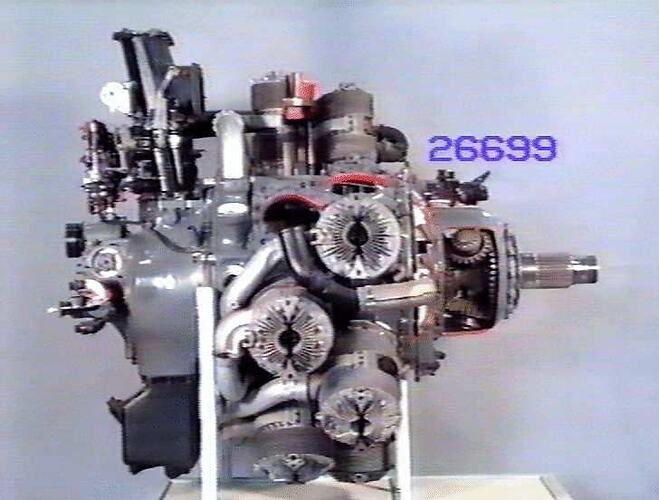Beginning in the mid 1920s, the Bristol Aeroplane Co. at Filton in the United Kingdom, developed a series of high-performance supercharged radial aero engines based on the sleeve valve principle. Instead of conventional external valves and pushrods, the valve mechanism is essentially a single steel cylinder with four holes which is located inside the cylinder heads and moves in sequence with the piston to complete the four-stroke cycle. This arrangement has the advantage of eliminating constant valve adjustment and valve load limitations and produces a neat, compact design which can be fitted inside a close-fitting engine cowling to reduce drag.
Following on from the nine-cylinder Perseus, the fourteen-cylinder, two-row Hercules was first tested in 1936 and was later displayed at the Paris Aero Show in November that year. The Hercules was subsequently developed for military use and was fitted to Royal Air Force bombers including the Stirling III, Halifax III & VII, Lancaster II and Wellington X. Probably the best known Hercules-powered aircraft was the Bristol Beaufighter. With the exception of the Beaufighter II (powered by the Rolls-Royce Merlin XX), the Hercules was used in all production versions of the twin-engined Beaufighter and proved to be a reliable and efficient power-plant with excellent performance at low-level. The Hercules XVIII was fitted with cropped supercharger impeller blades giving more power at low altitude which suited the Beaufighter's major combat role as an anti-shipping and ground-attack machine.
The Beaufighter was also built in Australia by the Beaufort Division of the Department of Aircraft Production as a follow-on project after DAP Beaufort bomber production ceased in 1944. From late 1944, Australian-built Beaufighter Mk. 21 aircraft operated alongside British-built examples in RAAF service where they flew in New Guinea with 30 Squadron and from the Northern Territory with 31 Squadron. RAAF Beaufighters were later operated from Morotai near Borneo. The Hercules XVIII engines for the Australian-built Beaufighters were imported from the UK. An estimated 57,400 Hercules engines were built during the Second World War. Later, civilian versions of the Hercules were fitted to Bristol Freighter cargo aircraft which operated in Australia in the post-war period.
More Information
-
Keywords
-
Localities
-
Authors
-
Article types


